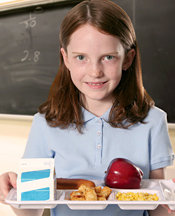The ABCs of Nutrition
By Claudia Anrig, DC
While school lunch programs have begun to address the issue of nutrition, lunch lines across the country still provide pizza, Sloppy Joes, cheeseburgers, corn dogs and other high-fat, nutrient-deficient items. It's time to teach our children there's a healthier way to eat.
Most parents recognize the importance of feeding their children nutritious foods. The problem is that in most schools, cafeteria food just doesn't cut it, and most parents don't exactly pack the ideal foods for their children to take to school every day. Between a busy family schedule, the picky eating habits of your children, and the ever-increasing array of unhealthy products marketed specifically to children, you may be losing the battle to provide your children with sound nutrition. Here are a few easy suggestions on how to improve their daily diet at school and at home.
Sandwich Suggestions
Parents purchasing white bread often equate "enriched" with healthy. Not true: White bread goes through a bleaching process that removes most of the nutrients. That's why it's white. Parents then combine this nutrient-deficient bread with something equally as unhealthy; peanut butter (most brands contain hydrogenated oil) and jelly (which often contains processed sugar), processed meats (almost all of which are filled with chemicals) and cheeses (often a processed food instead of the real thing).
 A better sandwich suggestion includes whole-grain bread, natural almond butter and unsweetened jelly, baked or roasted meats, and sliced vegetables (cucumbers, red peppers, etc.). Don't forget some sprinkles of flax seed. Another great sandwich option is a "wrap." This can be done by purchasing whole-grain or gluten-free tortillas and wrapping up healthier protein and vegetable sources. For example, start with baked turkey or chicken and add any or all of the following: cucumbers, sprouts, red peppers, hummus or a handful of beans. These choices are a definite improvement over what most children consume during their lunch hour.
A better sandwich suggestion includes whole-grain bread, natural almond butter and unsweetened jelly, baked or roasted meats, and sliced vegetables (cucumbers, red peppers, etc.). Don't forget some sprinkles of flax seed. Another great sandwich option is a "wrap." This can be done by purchasing whole-grain or gluten-free tortillas and wrapping up healthier protein and vegetable sources. For example, start with baked turkey or chicken and add any or all of the following: cucumbers, sprouts, red peppers, hummus or a handful of beans. These choices are a definite improvement over what most children consume during their lunch hour.
Pack It Right
Part of putting together a healthy packed lunch is having the right storage containers. Be sure to use an insulated lunch box that will hold up to four small food containers and a thermos. When purchasing lunch containers, consider purchasing at least two sets; this will eliminate the hassle of having to wash them each night. As for the thermos, be sure it is the wide-mouth variety, which can be used for many purposes (drinks, soup, etc.).
Water Is Best
When it comes to healthy lunches, milk, juice and soda should be avoided whenever possible. According to the American Academy of Pediatrics, juice consumption contributes to cavities and gastrointestinal issues in children. Many health authorities believe milk plays a role in childhood allergies. So, what should they drink? The best choice is water in a stainless steel container. That way, you're promoting "green" and at the same time saving money by not using plastic bottles.
Easy Entrées
Cubes of baked chicken, turkey or tofu are all great sources of protein that can be packed in a small lunch container. Limit processed meats (some children develop allergies, headaches and behavioral problems from the chemicals in processed meats) and plan ahead when making dinner. Leftovers can be cut into bite-sized pieces and eaten as finger food. A hard-boiled egg is also a great source of protein.
That wide-mouth thermos can bring great variety to an average lunch. Chili beans (another great source of protein) with organic tortilla chips for dipping can break up a boring lunch routine. At home, start to prepare homemade soups and stew, which will help steer your children away from the chemicals and high salt content found in many store-bought brands.

